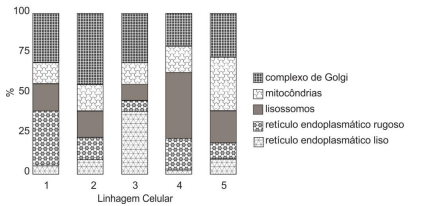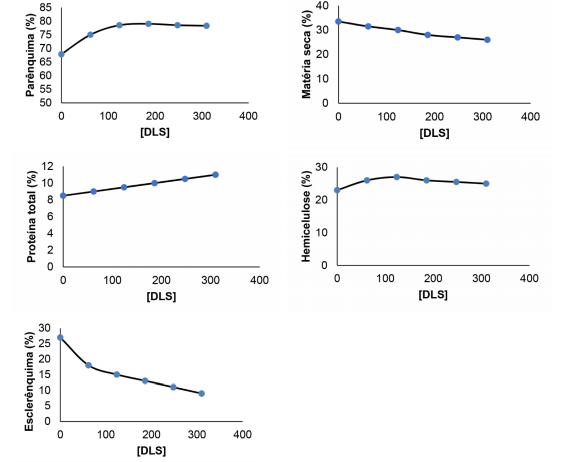Questões Militares
Para ufpr
Foram encontradas 801 questões
Resolva questões gratuitamente!
Junte-se a mais de 4 milhões de concurseiros!
O cultivo de células tem sido utilizado como uma possível alternativa para a produção de moléculas úteis na medicina, como a produção de hormônios naturais. Com a intenção de produzir hormônios como a testosterona e a progesterona, que são derivados do colesterol, pesquisadores tiveram que selecionar uma linhagem de células a partir da caracterização morfológica delas. Na figura abaixo estão apresentadas essas características
 .
.
A partir da observação, qual é o número da linhagem selecionada para atingir o objetivo pretendido?
A grama-missioneira-gigante (um híbrido de Axonopus jesuiticus × A. scoparius) é utilizada para alimentação animal em pastagens da região Sul do Brasil. Para estudar formas de melhorar sua digestibilidade, foi aplicado dejeto líquido suíno (DLS), em diferentes concentrações, sobre áreas com a grama, por dois anos. Os demais parâmetros do experimento foram controlados. Os resultados observados estão apresentados nas figuras abaixo:

O componente que teve relevância para o aumento da digestibilidade em função do aumento da concentração de
DLS foi
Assinale a alternativa que relaciona corretamente os níveis tróficos dos organismos constituintes da teia alimentar representada ao lado.

Uma grande população de insetos de uma determinada espécie é submetida a um dado inseticida por um período prolongado de tempo. Como consequência, os indivíduos sensíveis ao inseticida morrem e os resistentes a ele sobrevivem. A respeito da seleção natural atuante nessa população, considere as seguintes afirmativas:
1. Por promover o aumento da ocorrência de mutações de resistência ao inseticida, a seleção natural direcional ajustou a frequência dos insetos resistentes.
2. Geração após geração, a seleção natural estabilizadora promove o aumento da ocorrência de mutações de resistência ao inseticida.
3. Insetos resistentes ao inseticida aumentam de frequência, geração após geração, pela ação da seleção natural estabilizadora.
4. A seleção natural direcional favorece os insetos resistentes ao inseticida, que irão aumentar de frequência geração após geração.
Assinale a alternativa correta.
1. Descartes viajou para a Suécia com um robô escondido. 2. Os marinheiros abriram à força um baú que continha o simulacro de uma criança. 3. A tripulação fez uma apresentação do robô para os passageiros do navio. 4. Chocados com o que viram, os marinheiros jogaram o humanoide ao mar.
Assinale a alternativa correta.
Qual é a relação entre força e política expressa pelo autor nesse excerto?
Com base nessa passagem de O Manifesto Comunista, assinale a alternativa correta.
Com base no texto, é correto concluir que: